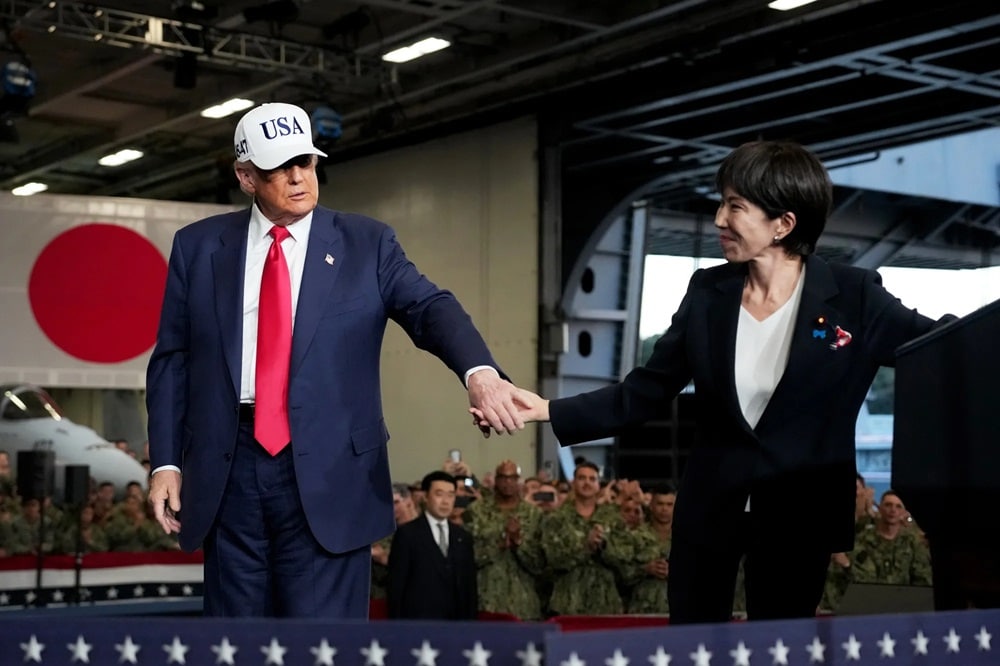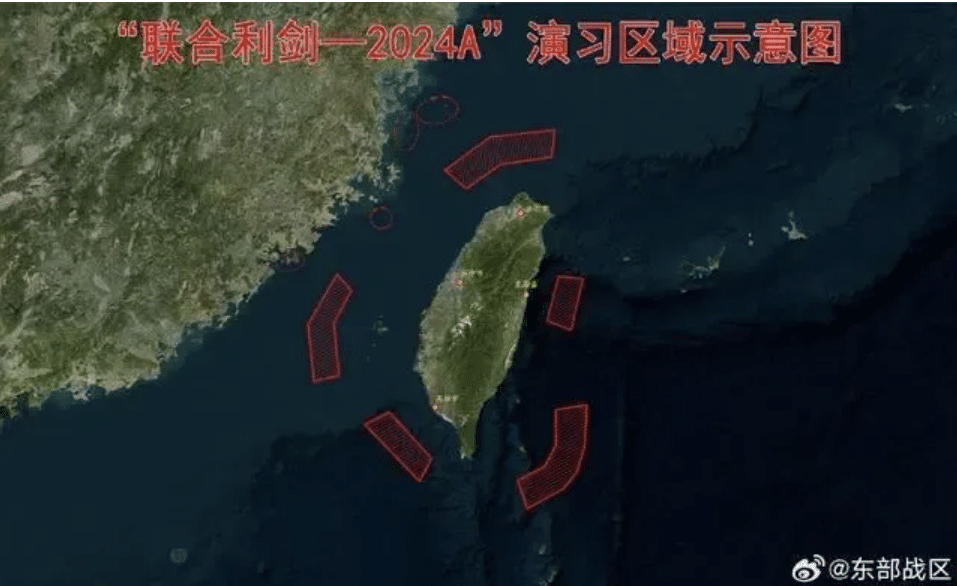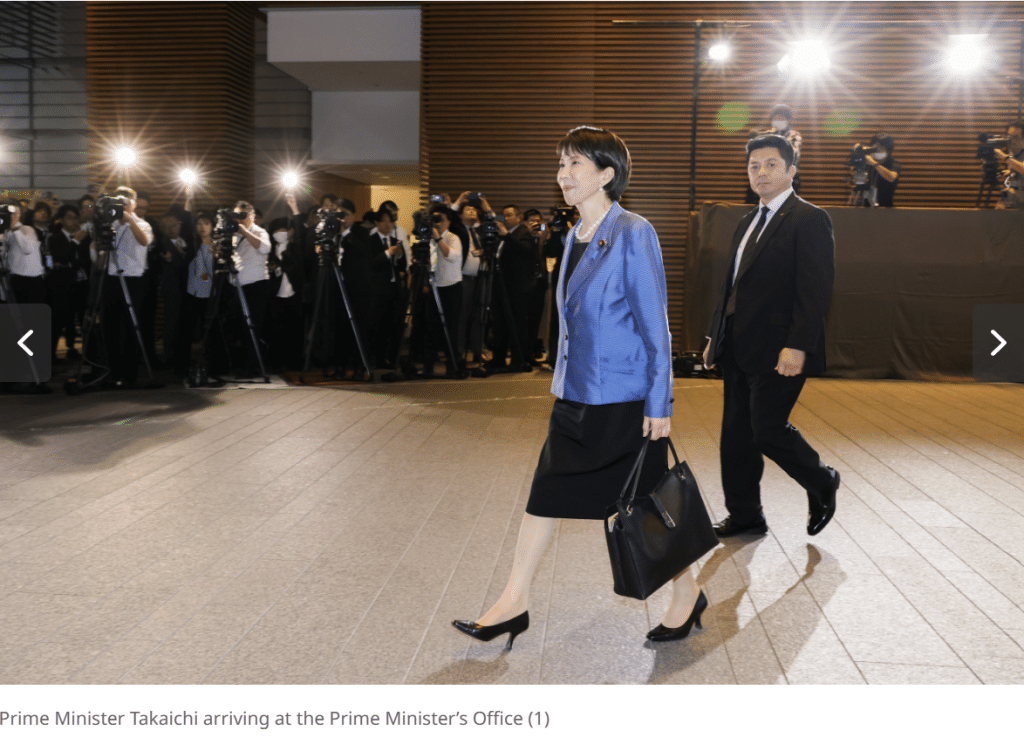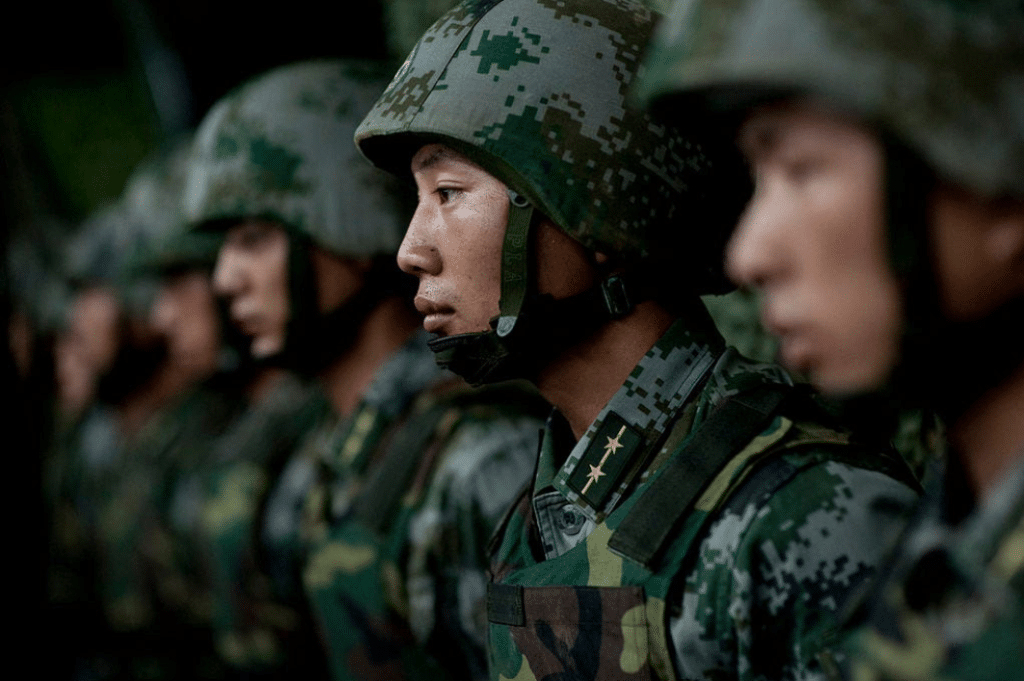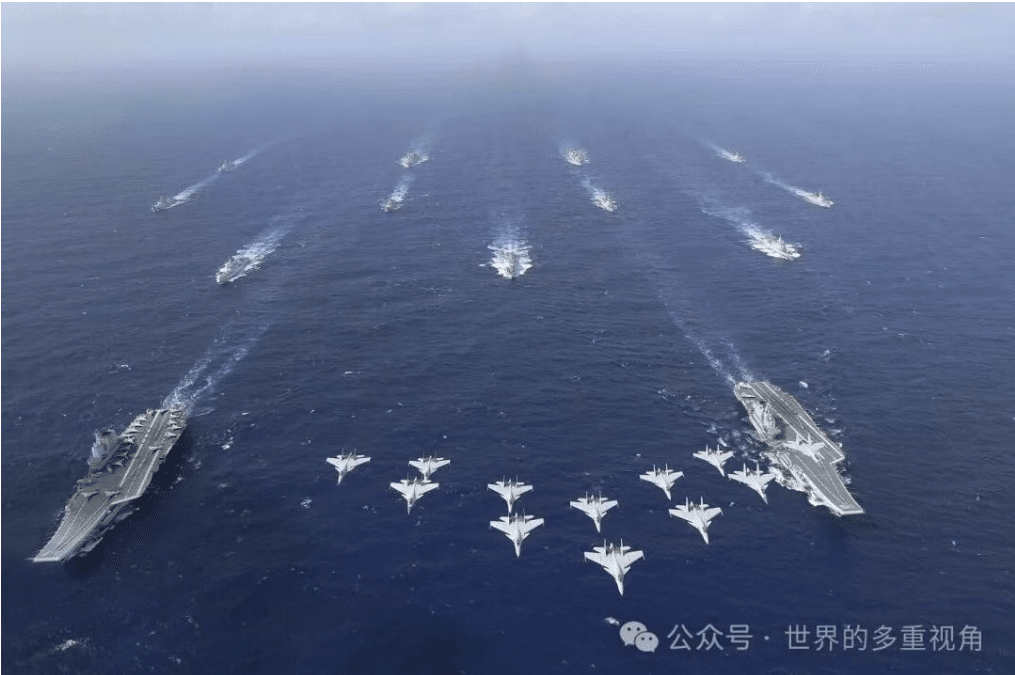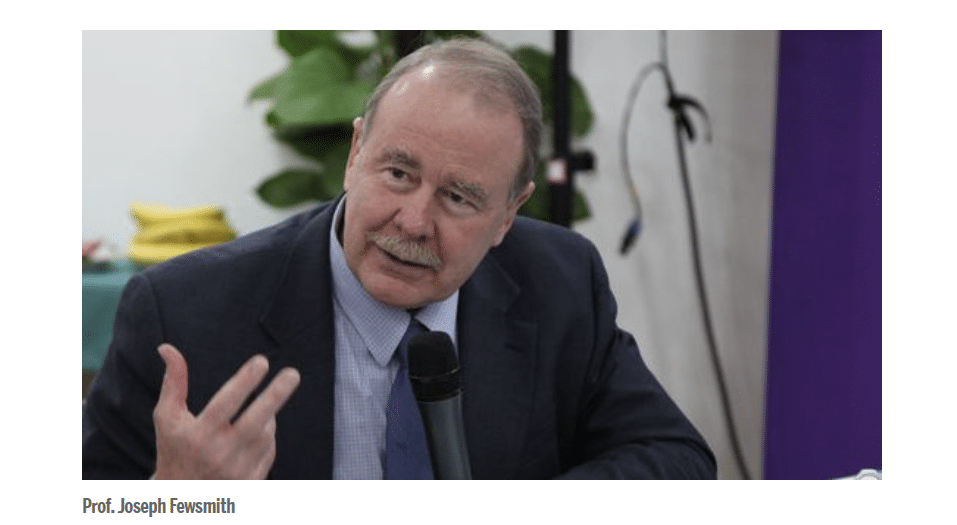President Trump’s Quiet Diplomacy Behind U.S.–China–Japan Phone Calls
Dark Side of the Moon
- Analysis
 Miranda Wilson
Miranda Wilson- 06/24/2025
- 0

On March 28th, 2025, Myanmar was hit with a devastating earthquake that killed over 3,600 people and left 17.2 million in need of humanitarian assistance. Six months ago, it would have been the exact situation USAID would involve itself. Instead, in the wake of the Trump administration gutting the agency, China stepped in.
Chinese teams arrived 18 hours after the earthquake, sending around 400 personnel and providing $14 million in aid, also assisting in Thailand. March 31st, 3 days after the initial shock, the United States pledged $2 million in aid, a number comparable to previous natural disaster assistance efforts. However, the funding came from a small emergency fund and the response was much slower than usual. As one ABC News article reported, this was a huge “public relations win for China.”
China’s tightening relationship with Myanmar is nothing new. President Xi Jinping visited Myanmar in 2020 to “deepen the high-quality cooperation on jointly building the China-Myanmar Economic Corridor,” according to a PRC Ministry of Foreign Affairs press report. In January of 2023, Director-General of the Department of Asian Affairs of the Foreign Ministry Liu Jinsong met with Myanmar Ambassador to China Tin Maung Swe. The topics of this meeting included bilateral relations and China’s commitment to helping its neighbors with their COVID-19 responses as well as pandemic prevention.
The same press release used the Myanmar proverb “လသာတုန်းဗိုင်းငင်,” which means “weaving while the moon is shining bright.” The phrase means to seize opportunities or make the best use of time under the given circumstances. It is an apt phrase for current China-Myanmar relations, and the implication of working under the cover of night is also relevant.
China’s commitment to Myanmar is not all positive. Myanmar has been stuck in a brutal civil war since 2021, and China has exerted considerable influence. The civil war started between the National League for Democracy (NLD), which won the national election democratically in 2020, and Myanmar’s military junta, who staged a coup against the NLD in 2021. China has provided military and financial support to the junta and different armed rebel groups; the junta have been responsible for a plethora of human rights abuses throughout the war.
When asked for comment on Beijing’s relations with different powers in Myanmar, Hunter Marston, Adjunct Fellow with the CSIS Southeast Asia Program and an Associate with 9Dashline, explained:
Beijing has gradually increased its support for the SAC [State Administrative Council - the military junta], though it has still refrained from overt diplomatic recognition of the junta or giving Min Aung Hlaing the leadership level engagement that he truly desires to legitimate his regime. That said, Beijing continues to engage a variety of stakeholders, primarily the ethnic armed groups in northern Myanmar with whom it has the most influence. Despite China's broad-based engagement efforts, Beijing has dialed back its engagements with the NUG [National Unity Government] regardless of the PDFs' [People’s Defense Force] battlefield advances and the steady erosion of the Myanmar military's hold over territory.
Still, if the United States wanted a closer relationship with Myanmar, it needed to act a long time ago. It could have taken advantage of anti-Chinese sentiment in the country, which grew in 2024 due to China’s backing of the junta.
As Marston explained:
The majority of Myanmar rightly perceives Beijing as throwing its support behind the military junta and not on the side of the resistance. Therefore China has little hope of expanding its soft power in the country. Yet at the same time, the NUG and various other ethnic armed groups are pragmatic enough to recognize that China's influence and presence in the country are not going away. Beijing is an important economic and diplomatic partner despite the largely negative perception of its role and influence in the country's current conflict.
USAID’s record in Myanmar is also not all positive. Dr. Elliot Prasse-Freeman, an Assistant Professor of Anthropology at the National University of Singapore, commented on USAID’s activities in Malaysia. He stated, “The end of USAID, both in Myanmar and beyond, should leave those committed to global justice deeply ambivalent. On one hand, the depth and scope of the cuts to life-saving aid are vast: perhaps a million people will die around the world because of USAID’s elimination…On the other hand, USAID has always acted as a soft-power arm of US Empire, fashioning a fig leaf under which the U.S. has brutally advanced its own self-interests.”
For Myanmar specifically, Dr. Prasee-Freen shared that he has been “perpetually shocked at the instrumental and opportunistic ways that the U.S. has engaged the country.” He furthered, ‘“from using sanctions to look good on human rights during the 2000s (thereby deflecting attention from its nefarious partnerships with other authoritarian states), to flipflopping to an ‘engagement’ strategy under Obama that helped facilitate authoritarian neoliberalism under Suu Kyi, the U.S. has never enacted a ‘values-based’ foreign policy.”
If the United States wanted a closer relationship with Myanmar, it needed to act a long time ago. It could have taken advantage, for better or for worse, of anti-Chinese sentiment in the country, which grew in 2024 due to China’s backing of the junta. China’s geographic location next to Myanmar will always give it the upperhand for security and economic reasons, but the earthquake would have been yet another chance for the United States to prove itself. The slow response and overall disinterest in the civil war makes the gap for China to fill all the more tempting.
One pertinent question is — is China’s humanitarian assistance related to its goals for the civil war? The West had already largely turned a blind eye to the war; does USAID being dismantled really make that much of a difference for Myanmar?
Dark Side of the Moon
China’s motivations for influencing the civil war in Myanmar are varied and depend on who you ask. The Stimson Center frames China’s interest as mostly an economic one, wanting to protect its assets and investments. An article by The Economist emphasizes political motivations such as China’s desire to suppress Western influence and protect an oil and gas pipeline that would become important for moving supplies if the United States and China ever went to war. Whatever the motivation, China seems to believe the junta is the only side that can provide stability to the country and a democratic transition is not possible.
In 2024, Chinese Foreign Minister Wang Yi pledged $3 million to the junta, with earmarked funds for “elections” and a census. China is one of the main providers of aviation assets and artillery for the junta, both before and after the coup. They have also supplied information technology through Huawei, which, according to the Stimson Center, has “assisted societal repression” and weakened “urban guerrilla operations.” Since the coup, China has sold $267 million in weaponry to Myanmar, only behind Russia ($406 million).
The BRI-led China-Myanmar Economic Corridor (CMEC) has also been linked to civil war influence. According to interviews led by writers for The Diplomat, the CMEC “is predominantly seen as sustaining the junta’s war efforts and benefiting its cronies.” Cross-border economic activity enabled by the CMEC has made border crossings an active target in warfare.
The CMEC involves many Chinese business activities, including mining for rare earth minerals, a process that is extremely damaging to the environment. The Diplomat also expresses that Chinese businesses have taken advantage of the breakdown in Myanmar, especially those in the extractive and cybercrime industries. The article concludes that the CMEC is now associated with “wartime resource exploitation” rather than development, and “this has dealt a further blow to China’s image and the popularity of its economic presence in Myanmar.”
The current state of the war is not in the junta’s favor. Different rebel groups have won back territory and seem to have the upperhand militarily. Domestic and international support for the National Unity Government (NUG) have risen. According to the United States Institute of Peace, a 2024 survey revealed that 93% of respondents in Myanmar hold a favorable opinion of the NUG. The NUG is recognized as Myanmar’s legitimate government by the United States, European Union, and Australia.
Even with the shrinking possibility of a junta victory, China has not backed down. The Stimson Center report emphasizes, “China’s support for the junta has not only not abated, but expanded, as it desperately tries to shore up an economically incompetent and militarily over-stretched junta.”
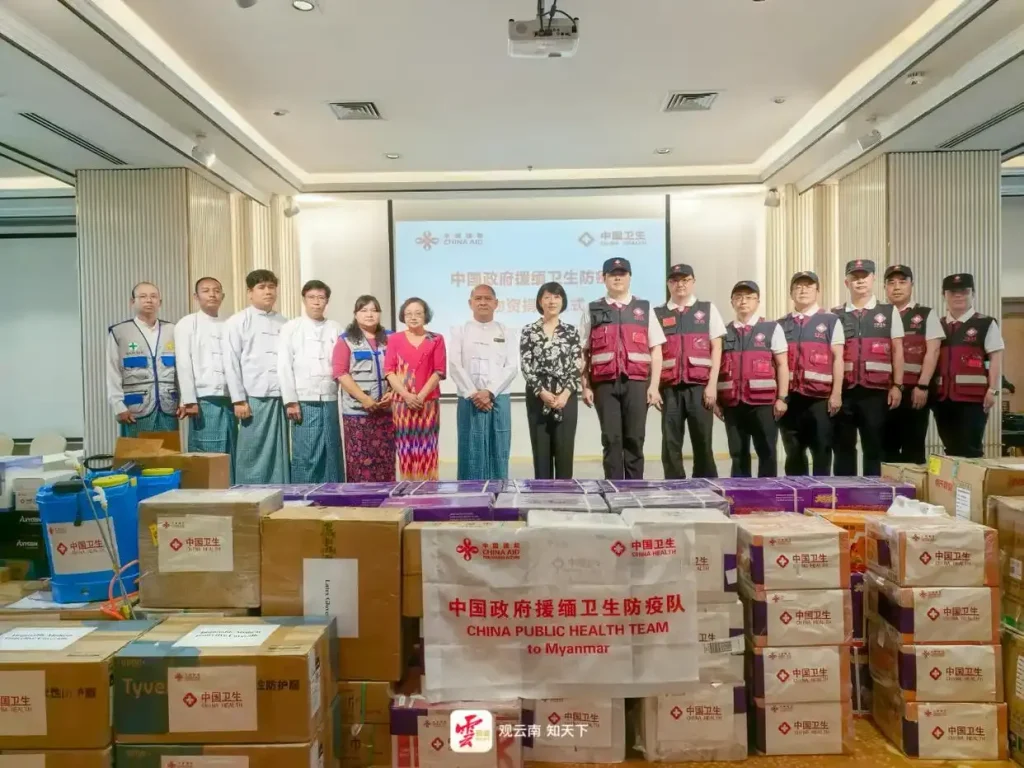
Earthquake Relief and Military Assistance
The CMEC’s initial goal might have been one of positive economic development, but the mission has become warped by China’s ongoing involvement in the civil war. However, China’s earthquake relief likely served a different interest: improving its image. As the United States shrinks from the global stage, China has the chance to portray itself as a good neighbor and reliable ally. In the wake of the earthquake, China seized the opportunity, “weaving under the moonlight,” and filled the gap of USAID. Whether that will improve its image in the eyes of Myanmar’s population in the long term is yet to be seen, but it was certainly a win on the U.S.-China competition front. It signaled that the United States might not always be consistent with its aid, but China will always be there for its neighbors.
And, social media posts from those in Myanmar have expressed gratitude towards Beijing for their help after the earthquake. According to Reuters, videos of Chinese first responders, as well as their Russian and Indian colleagues, have circulated the internet. The responders “pulled dazed survivors and bodies out of the rubble of hotels, schools, and monasteries.”
It seems like the earthquake provided China two chances to improve its image: first, globally and second, in Myanmar, especially important due to its unpopularity for supporting the juntas.
The broader takeaways should be twofold. First, as other countries fill in for the lack of USAID, does it matter where aid comes from? It seems that China’s earthquake aid was purely humanitarian, so does it actually matter if it comes from the United States or China? As Dr. Prasse-Freeman shared, USAID should be viewed with some ambivalence. It seems we should be questioning the ethics around aid as a whole rather than which country it comes from.
Second, a critical eye should be directed at China’s involvement in the civil war. Whether the junta wins or not, China will likely continue to exert political and diplomatic influence. The West was never that interested in Myanmar’s civil war, so perhaps Myanmar was always meant to stay closely tied to the superpower it shares a border with.
When asking Dr. Prasse-Freeman to comment for the article, he wrote a very relevant and important response to the issue of USAID and China-Myanmar relations. While several sentences were pulled for the article, it is worth reading his response in its entirety:
The end of USAID, both in Myanmar and beyond, should leave those committed to global justice deeply ambivalent. On one hand, the depth and scope of the cuts to life-saving aid are vast: perhaps a million people will die around the world because of USAID’s elimination. And in Myanmar, the removal of the $1 billion in earmarked aid over Trump’s term will be devastating, as those funds are devoted directly to keeping people alive: the US has already directed $2.4 billion to care for Rohingya refugees in Bangladesh (created when the Myanmar military forced 800,000 Rohingya out of their homelands in 2017). Given that Rohingya aid from other sources has already dropped precipitously, and end to US support will be catastrophic.
On the other hand, USAID has always acted as a soft-power arm of US Empire, fashioning a fig leaf under which the US has brutally advanced its own self-interests. As a teacher (and student) of Southeast Asian history, I ask pupils to grapple with how the same institution responsible for saving lives could also facilitate unconscionable realpolitik that has had knock-on effects that perhaps outstrip any good that it has done. As David Price’s work has recently uncovered, USAID facilitated counterinsurgency warfare in Vietnam and helped support mass killings in Indonesia. In Myanmar US involvement has always had ambiguous effects: the CIA funded the Kuomintang to start the Golden Triangle drugs trade that destabilized Burma for a half-century. I have worked on Myanmar since 2003 and have been perpetually shocked at the instrumental and opportunistic ways that the US has engaged the country – from using sanctions to look good on human rights during the 2000s (thereby deflecting attention from its nefarious partnerships with other authoritarian states), to flipflopping to an ‘engagement’ strategy under Obama that helped facilitate authoritarian neoliberalism under Suu Kyi, the US has never enacted a “values-based” foreign policy. As the US continues to fund and support Israel’s genocide in Gaza today, it seems nothing less than absurd to recommend more US engagement in places around the world. With friends like these, as they say.
Where does this leave Myanmar? In China and the US, Burmese people are stuck between two self-interested hegemons. It is easy to recommend that the Burmese reject both and forge their revolution “on their own.” But the sheer size of these forces – and the material resources they can bring to bear to either help or hurt the revolution – makes them impossible to ignore. Is it necessary to engage them (as revolutionary militants did when China supported Operation 1027 in 2023)? What are the ways such engagement could occur without succumbing to institutional or ideological capture? There are no clear answers to these questions. One hope is that global solidarity networks could circumvent the US and China to assist Burma’s revolution. But what specific relationships that could be developed and institutions built remain to be explored.
Miranda Wilson is managing editor of the U.S.-China Perception Monitor and a J.D. candidate at Vanderbilt Law School.
The views expressed in this article represent those of the author(s) and not those of The Carter Center.

